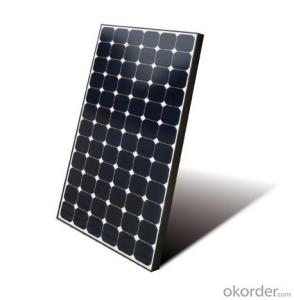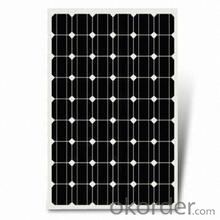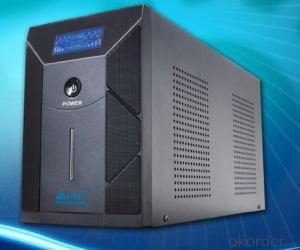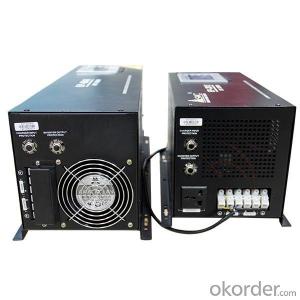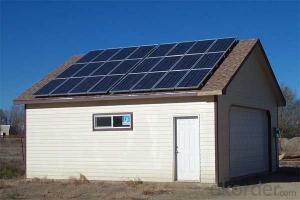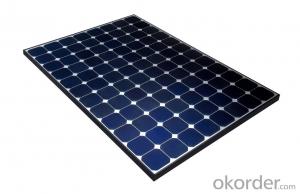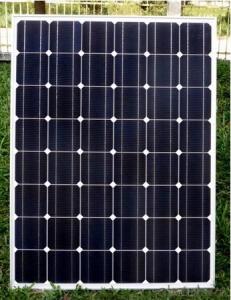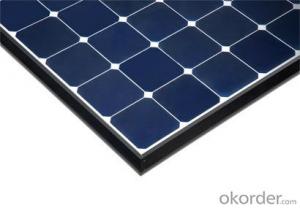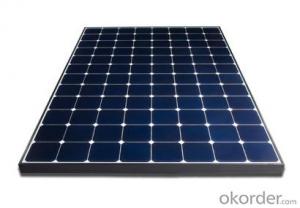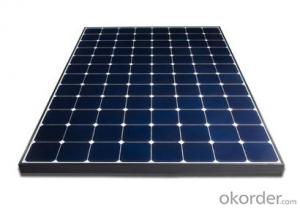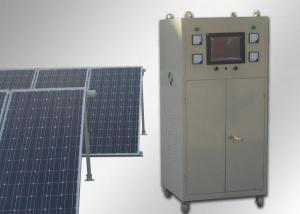Solar Energy Systems Canada - CNBM On Grid System 900W with Certificate UL TUV CE
- Loading Port:
- Shanghai
- Payment Terms:
- TT OR LC
- Min Order Qty:
- 100 watt
- Supply Capability:
- 1000 watt/month
OKorder Service Pledge
OKorder Financial Service
You Might Also Like
Specification
CNBM On Grid System 900W with Certificate UL TUV CE
Product description
A grid-connected photovoltaic power system, or grid-connected PV system is anelectricity generating solar PV system that is connected to the utility grid. A grid-connected PV system consists of solar panels, one or several inverters, a power conditioning unit and grid connection equipment. They range from small residential and commercial rooftop systems to large utility-scale solar power stations. Unlike stand-alone power systems, a grid-connected system rarely includes an integrated battery solution, as they are still very expensive. When conditions are right, the grid-connected PV system supplies the excess power, beyond consumption by the connected load, to the utility grid.
Connection of the photovoltaic power system can be done only through an interconnection agreement between the consumer and the utility company. The agreement details the various safety standards to be followed during the connection.[4]
Grid-connected PV can cause issues with voltage regulation. The traditional grid operates under the assumption of one-way, or radial, flow. But electricity injected into the grid increases voltage, and can drive levels outside the acceptable bandwidth of ±5%.[8]
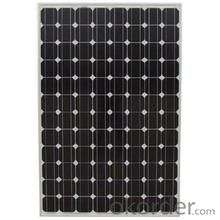
Application
Industrial
Commercial
Residential
Feature
Residential, grid-connected rooftop systems which have a capacity more than 10 kilowatts can meet the load of most consumers.[2] They can feed excess power to the grid where it is consumed by other users. The feedback is done through a meter to monitor power transferred. Photovoltaic wattage may be less than average consumption, in which case the consumer will continue to purchase grid energy, but a lesser amount than previously. If photovoltaic wattage substantially exceeds average consumption, the energy produced by the panels will be much in excess of the demand. In this case, the excess power can yield revenue by selling it to the grid. Depending on their agreement with their local grid energy company, the consumer only needs to pay the cost of electricity consumed less the value of electricity generated. This will be a negative number if more electricity is generated than consumed.[3] Additionally, in some cases, cash incentives are paid from the grid operator to the consumer.
Packaging
With carton and box
- Q: How do solar energy systems impact regional economic development?
- Solar energy systems have a positive impact on regional economic development in several ways. Firstly, they create job opportunities in the installation, manufacturing, and maintenance sectors. This leads to increased employment rates and income levels, stimulating economic growth. Secondly, by reducing reliance on fossil fuels, solar energy systems lower energy costs for businesses and households, freeing up funds that can be invested in other sectors. Furthermore, solar projects attract investment and promote innovation, fostering a sustainable and resilient economy. Overall, solar energy systems contribute to job creation, cost reduction, and investment attraction, all of which drive regional economic development.
- Q: What is the impact of temperature fluctuations on the performance of solar panels?
- Temperature fluctuations can have a significant impact on the performance of solar panels. When exposed to high temperatures, the efficiency of solar panels tends to decrease, leading to a decrease in power output. This is primarily due to the nature of the materials used in the panels, such as silicon-based photovoltaic cells, which are sensitive to temperature changes. One of the main effects of high temperatures is an increase in the resistance within the solar panels. This increased resistance causes losses in electrical current flow and reduces the overall efficiency of the panels. Additionally, high temperatures can cause the semiconductor material in the panels to expand, leading to microcracks or other structural damage. This can further reduce the efficiency and lifespan of the panels. On the other hand, extreme cold temperatures can also negatively impact the performance of solar panels. In cold conditions, the conductivity of the materials used in the panels decreases, leading to higher resistive losses. Additionally, snow or ice accumulation on the surface of the panels can restrict sunlight absorption, further reducing power output. To mitigate the impact of temperature fluctuations, solar panels are often designed with thermal management systems. These systems help dissipate excess heat and maintain an optimal operating temperature range for the panels. Common techniques include the use of cooling fluids, heat sinks, or ventilation systems. By controlling the temperature, the performance and longevity of solar panels can be improved. It is worth noting that while temperature fluctuations can affect the efficiency of solar panels, they still remain a viable and sustainable source of energy. Advances in solar technology, such as the development of more temperature-resistant materials and improved thermal management systems, continue to enhance the performance and reliability of solar panels in various climatic conditions.
- Q: Can a solar energy system be installed on a museum or cultural institution?
- Yes, a solar energy system can be installed on a museum or cultural institution. Solar panels can be mounted on the roof or in an open space surrounding the building to harness sunlight and convert it into electricity. This can help the institution reduce its reliance on conventional energy sources, lower its carbon footprint, and potentially save on electricity costs in the long run. Additionally, the installation of solar panels can also serve as an educational display, highlighting the institution's commitment to sustainability and renewable energy.
- Q: How does solar energy impact the environment?
- Solar energy has a positive impact on the environment as it is a clean and renewable source of energy. By harnessing the power of the sun, solar energy reduces greenhouse gas emissions, air pollution, and dependence on fossil fuels. Additionally, it helps in conserving valuable resources and mitigating climate change, making it a sustainable and eco-friendly option for meeting our energy needs.
- Q: Are there any maintenance costs associated with solar energy systems?
- Yes, there are maintenance costs associated with solar energy systems. While solar panels require very little maintenance compared to other energy systems, there are still some costs involved. These costs include regular cleaning of the panels to ensure maximum efficiency, inspection and repair of any damaged or malfunctioning components, and periodic replacement of parts that may wear out over time. Additionally, solar energy systems may require monitoring and maintenance of the batteries or inverters that store and convert the energy. It is also recommended to have a professional conduct an annual inspection to ensure the system is functioning properly. While these maintenance costs are typically low compared to the savings generated by solar energy, it is important to factor them into the overall cost analysis when considering the installation of a solar energy system.
- Q: Are there any regulations or permits required for installing solar energy systems?
- Solar energy systems require regulations and permits for installation. The specific requirements vary depending on the location and jurisdiction, as regulations are set at local, state, and national levels. These regulations and permits are in place to ensure the safety of solar energy system installations, compliance with building codes, and adherence to local zoning requirements. Typically, a solar energy system installation requires a building permit. This permit guarantees that the installation is done correctly and follows all necessary safety guidelines. The permit process involves submitting detailed plans and documentation, including structural engineering reports and electrical diagrams. The local building department reviews these documents to ensure compliance with applicable codes and regulations. In addition to building permits, there may be other permits or approvals necessary for solar energy systems. These could include electrical permits, zoning permits, or even historic preservation approvals in certain areas. It is crucial to consult with the relevant authorities and obtain all necessary permits before installing a solar energy system to avoid legal or safety issues. Furthermore, some jurisdictions have specific regulations regarding the size, placement, and design of solar energy systems. These regulations aim to preserve the aesthetics of the area and ensure that the systems do not pose any risks or nuisances to neighboring properties. It is important to note that regulations and permit requirements are constantly changing and can differ significantly from one jurisdiction to another. Therefore, it is advisable to consult with local authorities or hire a professional solar energy installer who is familiar with the local regulations to ensure compliance throughout the installation process.
- Q: Can solar energy systems be used in conjunction with backup generators?
- Yes, solar energy systems can be used in conjunction with backup generators. This combination allows for a reliable and uninterrupted power supply, as solar panels can generate electricity during the day while excess energy can be stored in batteries or fed back into the grid. Backup generators can then be used as a secondary power source during periods of low solar generation or in case of emergencies.
- Q: What is the role of solar water pumps in solar energy systems?
- The role of solar water pumps in solar energy systems is to use solar power to pump water, eliminating the need for electricity or fuel. These pumps are cost-effective, environmentally friendly, and can be used in various applications, such as irrigation, livestock watering, and domestic water supply, making them crucial components of sustainable solar energy systems.
- Q: What are the benefits of using solar energy?
- There are several benefits of using solar energy. Firstly, it is a renewable and sustainable source of energy, meaning it does not deplete natural resources. Secondly, solar energy helps reduce greenhouse gas emissions, contributing to a cleaner and healthier environment. Additionally, using solar energy can lead to significant cost savings on electricity bills, as it reduces dependence on traditional utility companies. Furthermore, solar panels require minimal maintenance and have a long lifespan, making it a reliable and durable energy solution. Lastly, solar energy promotes energy independence, as it allows individuals and communities to generate their own power, reducing reliance on external sources.
- Q: How do solar energy systems affect electricity bills?
- Solar energy systems can significantly reduce electricity bills by generating renewable energy from the sun. By using solar panels to harness solar energy, households can generate their own electricity and become less reliant on the grid. This can lead to substantial savings on monthly bills, as the energy produced by the solar system offsets the need for electricity from the utility company. In some cases, solar energy systems can even result in net metering, where excess energy generated is fed back into the grid, further reducing or eliminating electricity bills altogether.
Send your message to us
Solar Energy Systems Canada - CNBM On Grid System 900W with Certificate UL TUV CE
- Loading Port:
- Shanghai
- Payment Terms:
- TT OR LC
- Min Order Qty:
- 100 watt
- Supply Capability:
- 1000 watt/month
OKorder Service Pledge
OKorder Financial Service
Similar products
Hot products
Hot Searches
Related keywords
